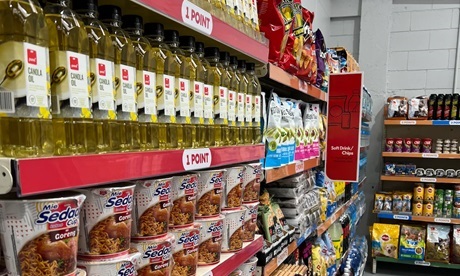If you’ve heard about social supermarkets at all, it’s probably because you saw them on the news.
In reports about the social initiative, politicians, supermarket bosses and social workers walk around makeshift grocery aisles uttering words like “dignity”, “choice”, “partnerships” and “affordability” to reporters desperate for a story that fits the “uplifting” slot.
How do they work?
In early April, South Auckland’s first social supermarket, Tatou, opened in Māngere. It’s Foodstuffs North Island’s 11th social supermarket, and the mega grocery retailer is about to announce its 12th.
Though it wasn’t exactly clear in media coverage of the opening how social supermarkets worked, the buzzwords were enough to soothe some of my catastrophic anxieties about food insecurity and inequity.
But I started to have questions. Could anyone just go at any time? Who qualifies as being in need? Does this actually free New Zealanders from the supermarket duopoly?
The idea of a social supermarket is to provide people who experience food insecurity the dignity of choosing what they need for themselves in a supermarket-style environment, rather than being given a pre-packed food parcel which might not meet the recipients’ needs.
Accessing social supermarkets involves wraparound services like financial mentoring and counselling.
But can the words “dignity” and “choice” coexist within a reality where the need for hardship grants and food assistance is increasing for families with children?
To access Tatou, the new social supermarket in Māngere, clients first go to Māngere Budgeting Services Trust in Onehunga.
They must speak to a financial mentor about their situation before they are set a number of points to “spend” at the social supermarket by appointment. Clients can usually get a shop done on the same or next day.
In the just under two months since Tatou’s opening, 94 whānau have shopped at the social supermarket.
Tatou keeps shelves stocked with a range of 750 grocery items through donations from PaknSave Māngere, funding from the Ministry of Social Development, and private donations.
Its chief executive, Lara Dolan, says the number of shopping trips that a client can access depends on the support needed “for family or individuals to get back on track”.
But this isn’t the case for all social supermarkets.
Stretching budgets
Steve, whose name has been changed for privacy, had been working in the public service for almost 20 years when he was recently made redundant.
Since then, he’s done a few rounds at the local social supermarket to support his wife, child, and pets. Steve can go three times a year and visits must be at least four weeks apart.
Steve, who is 45 years old, is on a sickness benefit and taking an indefinite break from work due to burnout.
“I don’t have a feeling of food insecurity, but the food banks and social supermarkets help me save money on food so I can pay for other necessities,” he says.
At the social supermarket he visits in west Auckland, he pays $40 for 65 points allocated to his family of three.
This makes his shop about a third cheaper than going to PaknSave, he says.
“You definitely can’t get all your groceries through a social supermarket. There’s a lot they don’t have like [fresh] meat and fresh milk. It just subsidises your weekly grocery shop.”
He says if you go to their budgeting advisor, you can go shopping four times a year.
But he says they “harass you to give your financial details, including letting them go through bank statements … I wasn’t going to show all my private information to them just so they would let me have one additional shop for the year.”
After making an appointment, Steve is put on a waiting list and waits anywhere between one to four weeks before his shop.
Sixty-five points gets Steve a large trolley full of groceries, including fresh vegetables, seven cartons of milk, a large bag of cat food, two boxes of laundry powder, a tray of sausages, and a large block of cheese.
In a food parcel, which is free from the same organisation, there’s usually a kilogram of chicken or mince, some bread, maybe some fruit and veges, and whatever else they have at the time, says Steve.
“Essentially all the stuff is past its best by date, but it’s still fine to eat. The meat is always frozen.”
So while Steve can get a food parcel the same day he turns up, there’s less choice compared to a social supermarket – but there are a few more barriers to jump over to access the latter.
“I have seen people crying in the office there,” Steve says. “I guess it’s really hard for some people to ask for help.”
Steve is grateful to have the support. But charitable food aid has been criticised as putting a band-aid over systemic inequality while benefiting the reputations of supermarket chains. Read more
- Eda Tang is a guest writer for The Spinoff
News category: Analysis and Comment.




